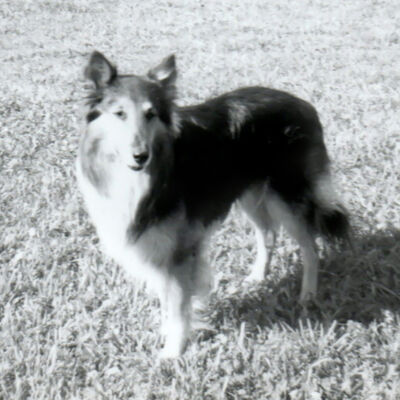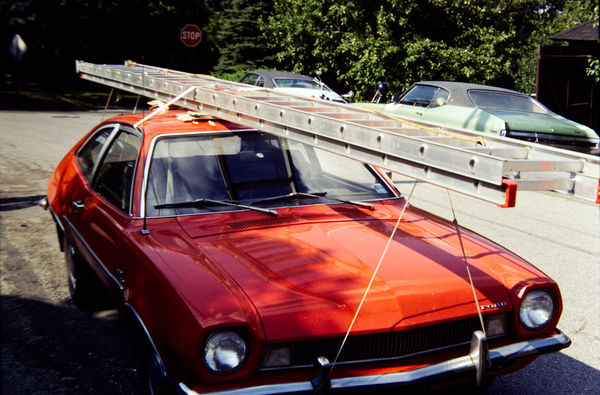Light source for converting slides to digital
Sep 14, 2020 12:16:00 #
burkphoto wrote:
When using any discontinuous spectrum light source... (show quote)
I recognize you know a whole lot more than most of us when it comes to this stuff, so I'm not arguing the points made. I myself don't care a whole lot when it comes to my old slides, but any problems with color I noticed appeared to be more problems with the original slides rather than the conversion process. My slides had repeated problems with focus, exposure and composition, because it was 40 years ago, I didn't know or much care what I was doing and so on.
However, here is an example of a slide from 1976 I converted with my Nikon 5300 and my homemade slide converter and cell phone flashlight as a light source. I didn't do any work on it because it was just a pic of my brother hauling a 40' ladder on his Pinto.
He stopped to show me how ridiculous it looked to carry this thing on his roof. The photo could be improved a lot but frankly not worth the effort. The colors however are 100% accurate, to the best of my recall. His Pinto was red, my Buick was green. How accurate I'm not sure, but close enough for me. The second pic is also from 1976 and the colors of my boat and everything else is exactly as I remember them. I could have easily manipulated the colors a lot if I had any reason to in post.
Also is a pic of my slide converter, before I added the extension tube to my 18-55mm zoom lens. I'll also note that I didn't need a tunnel to keep extraneous light out of the pic, but I did keep a bit of the slide sides in the pic and cropped them later. I think it would be hard to get a one to one full picture of the slide anyway.
Also I'll note that anyone building there own device, make sure you have an external power source for your camera, or, you can get at your battery w/o taking things apart.
Sep 14, 2020 16:40:35 #
BigDaddy wrote:
I recognize you know a whole lot more than most of... (show quote)
BigDaddy wrote:
I recognize you know a whole lot more than most of... (show quote)
That all looks pretty straightforward to me. Cell phone flashlights are decent, since they are designed to be used as photo "flashes".
I use my iPhone screen. I made a 255,255,255 white JPEG file and put it in Photos. Then I set the screen to never sleep, and plugged it into a charger. The bright white of the iPhone LEDs is not perfect, but damned good. I'm using a Lumix GH4 with 30mm f/2.8 Macro. Here are a couple of samples to add to the slides I posted in this thread. The B&W was from a 50-year old Tri-X negative (push developed in Acufine). The color scene of the cat was from 1977 Kodak Vericolor II. Note the uneven color... Vericolor II negative dye layers faded unevenly in the presence of heat. I don't have any that are any less uneven.
These were converted from raw files, in Adobe Lightroom Classic, using Negative Lab Pro plugin.
Sep 15, 2020 09:50:23 #
burkphoto wrote:
That all looks pretty straightforward to me. Cell phone flashlights are decent, since they are designed to be used as photo "flashes".
I use my iPhone screen. I made a 255,255,255 white JPEG file and put it in Photos. .
I use my iPhone screen. I made a 255,255,255 white JPEG file and put it in Photos. .
Yes, I got my idea of using my cell phone from you in a prior post. I couldn't figure out how to get the screen to light other than using the flashlight app. I had thought of taking a pic of something white, but figured this would work. (you neglected to mention how you actually did this, or I would have went the picture route). My method worked great, but I used a diffuser between my light and the slide. I'm thinking a diffuser wouldn't be needed if you used the phones picture of a white screen instead of the highly focused flashlight beam?
All my slides were stored in carousels since the 70's, and in my shed since 1988. Temperatures here range from 100+ to -20. and the highs in the shed probably a lot higher. Most of the slides were in decent shape although since I haven't seen them since the 80's, they may have deteriorated some. I recall them looking better when using a projector, but I also mainly just showed them on a white wall, so my "recall" is dubious at best:-)
It was a time consuming venture to say the least, but actually taking the picture was a snap. I could do slides as fast as I could stick them in and out of my holder. A LOT of time was trying to read the development dates on the slides, some didn't have them, some were very dim, and some fine. Sometimes a group of Christmas slides were dated March, even June, so I knew I had them sitting around for months before getting them developed.
I also cataloged every single slide, all the people, pets, occasions, everything. I even recorded what slide tray and position in the tray of each slide in the IPTC fields so I could retrieve the slide later if needed. Now, I can find every picture of my dog Maggie, cat JJ or Christmas 1976 at the click of a button. All the time was worth it, and actually an enjoyable enterprise.
Sep 15, 2020 14:40:50 #
The iPhone needs to be about two inches back from the slide or negative, to allow the shallow depth of field to throw the background of LEDs out of focus. I use f/5.6 to f/8, as a compromise between the need for some depth of field at high magnification, and the need to avoid diffraction limiting of sharpness.
It sounds like you have been extremely busy! I admire your organizational ambition.
It sounds like you have been extremely busy! I admire your organizational ambition.
Sep 25, 2020 18:00:50 #



--Bob
Gene51 wrote:
You might consider getting a scanner that can do slides and film. Much more manageable and no additional optics to degrade the image.
Sep 26, 2020 10:48:08 #
rmalarz wrote:


--Bob



--Bob
...except that many scanners use lenses to scan film. For instance, an Epson V850 has two lenses. It uses one for large format film, and one for high resolution scanning of small format slides and negatives.
Now, a lab scanner may not use a lens. At the lab where I worked in the early 2000s, we had nine high speed lensless Kodak scanners that moved the film across a scanning bar, using a high intensity light source and a stepper motor. But each of those cost $55,000 per setup... plus the network infrastructure and DP2 software license.
Sep 27, 2020 15:53:55 #
therwol
Loc: USA
burkphoto wrote:
...except that many scanners use lenses to scan film. For instance, an Epson V850 has two lenses. It uses one for large format film, and one for high resolution scanning of small format slides and negatives.
I believe the second lens in the V850 (and V800) is focused on the glass where you would put anything larger than 4x5. When scanning 4x5 with a film holder, the film is in the same plane as small format film or slides. You can specify whether you're putting the film on the glass or using a film holder before you scan it. (This is from memory. I have the V800, but I've only used film holders with it.)
If you want to reply, then register here. Registration is free and your account is created instantly, so you can post right away.







